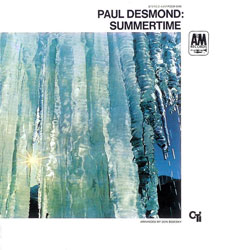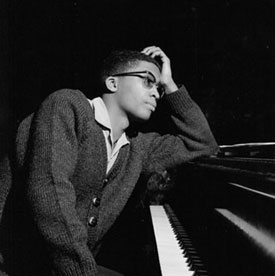

|
Soundclip:
|
| See Steve's Hand-Written Solo
Transcription |
Herbie
Hancock's Acoustic Piano solo on: "Someday My Prince Will Come"(Frank Churchill-Larry Morey) Over the years, after countless conversations with fellow musicians and students about the art of making music, I have often said, when commenting about the act of playing one's instrument, "in the end, everything comes down to touch!" Even though, the gorgeous solo piano introduction to this presentation of yet another Herbie Hancock solo does not appear in the soundclip you can hear, each time that I listen to it, I am struck by just how incredible Herbie's touch on that acoustic piano is.  No doubt, Herbie knew the piano at Rudy Van Gelder's studio intimately after so many of his own Blue Note recordings as a leader and countless others as a sideman, but his touch on the instrument is unmistakable. When I had decided to present Paul Desmond's solo on "Someday My Prince Will Come" from his 1968 recording, "SUMMERTIME"(A&M), I was not even thinking about transcribing Herbie's solo too, because of some of the rhythmic complexities of a couple of passages. But, my competitive nature got the best of me, and once I started down that road, I was not going to stop until I had it, or something close to it. In the end, I think that it is important to offer both solos, because these two musicians, on the surface, just seem to be coming from such different worlds and approaches to music-making. But, there is no denying that they made some beautiful music together. Prior to this particular solo, we had presented Herbie's solo on "Samba with some Barbeque" from this very same album, which one of the first solos ever presented at KORNER 2. No doubt, Herbie knew the piano at Rudy Van Gelder's studio intimately after so many of his own Blue Note recordings as a leader and countless others as a sideman, but his touch on the instrument is unmistakable. When I had decided to present Paul Desmond's solo on "Someday My Prince Will Come" from his 1968 recording, "SUMMERTIME"(A&M), I was not even thinking about transcribing Herbie's solo too, because of some of the rhythmic complexities of a couple of passages. But, my competitive nature got the best of me, and once I started down that road, I was not going to stop until I had it, or something close to it. In the end, I think that it is important to offer both solos, because these two musicians, on the surface, just seem to be coming from such different worlds and approaches to music-making. But, there is no denying that they made some beautiful music together. Prior to this particular solo, we had presented Herbie's solo on "Samba with some Barbeque" from this very same album, which one of the first solos ever presented at KORNER 2.Just as it was before, the core rhythm section is Ron Carter(acoustic bass) and Leo Morris(drums). Of course, Leo Morris later became known to most music fans as Idris Muhammad. There is no telling just how many times Herbie and Ron must have played "Someday My Prince Will Come" which, again, comes from the Disney animated classic, "SNOW WHITE AND THE SEVEN DWARFS," but surely their familiarity with the tune contributes to the very relaxed feeling throughout this performance, and Carter and Morris create a kind of glide to the rhythmic flow that makes one wish that most standards, when interpreted, could feel this way. When this performance was recorded, it would be my sense, based upon experience, that probably the only actual players present that day would have been Desmond, Hancock, Carter, and Morris with Don Sebesky there to provide a lead sheet, and some musical supervision with Creed Taylor and Rudy Van Gelder in the booth. Given that, it seems reasonable to assume that Sebesky already knew that there would be a brass send-off of 4-bars into Herbie's piano solo, which would then actually begin at bar 5. In sharp contrast to the very diatonic nature of Paul Desmond's playing, Hancock's solo is filled with chromaticism of all types: chromatic passing tones and his usage of both chromatic upper and lower neighboring tones. In Desmond's solo you hardly ever saw any accidentals, but here, they appear practically everywhere. During my analysis of the Desmond solo, I spoke about the Ab°7 chord that appears in bars 10 & 14 of each [A] section of the tune, and mentioned that that chord is actually a real diminished 7th chord, and not just the 3rd of a 7b9 chord. I went on to explain that you would want to use the Ab whole-step-1/2-step diminished scale: Ab, Bb, B, Db, D, E, F, G. And that, within that scale, you also have both major and minor triads built upon G, Bb, Db, and E. Right away, in bar 10, you can see that Herbie is employing that very scale as he descends from a high D-natural down to a resolution on F-natural for the Gm7 chord. When bar 14 arrives, he uses the better part of this same scale to ascend, but this time, as he going to use a form of the C altered dominant scale, the variant becomes the appearance of an F-natural. It is almost as if he is viewing or hearing through those final 3 bars of [A] as one long, extended V7(alt.) passage to eventually resolve to the Fmaj7 chord as [A2] arrives. As [A2] of Chorus 1 arrives, Herbie offers what is the most chromatic series of lines during this solo. He begins by highlighting long notes in each of the 1st 4 bars, as he seems cosmically driven to have his line descend in this manner. During bars 5-8, you can see that he shifts the rhythmic accentuations throughout the 16th-note sub-divisions. After the D-natural in bar 4, the accents fall on each of the chromatically descending notes, until finally, in bar 7, on beat 2, he arrives at middle-C, and the line turns, and ascends. The ascending line is, again, a hybrid form of a C altered dominant scale, this time both F-natural and G-natural appear. During bars 9-12, there is a beautiful ii-V to Bbmaj7, and then, a quick iim7b5-V to Am7.  I love Herbie's line configurations in these bars. I especially like the descending triplet in bar 10 which, depending upon your harmonic thinking, outlines an Ebm9 or Gbmaj7 arpeggio. Either way, over an F7(alt.) chord, you produce some great alterations, though the 4th(Bb) is often not recommended. However, here it is masked as it appears in the middle of the line, and one hardly notices it. For the last two bars, bars 15-16, Herbie is really ignoring the iim7 chord, and taking the long view of V-Imaj. As Chorus 2 begins, he has cadenced ever so gracefully to the main melody note of C-natural. I love Herbie's line configurations in these bars. I especially like the descending triplet in bar 10 which, depending upon your harmonic thinking, outlines an Ebm9 or Gbmaj7 arpeggio. Either way, over an F7(alt.) chord, you produce some great alterations, though the 4th(Bb) is often not recommended. However, here it is masked as it appears in the middle of the line, and one hardly notices it. For the last two bars, bars 15-16, Herbie is really ignoring the iim7 chord, and taking the long view of V-Imaj. As Chorus 2 begins, he has cadenced ever so gracefully to the main melody note of C-natural.During the first 8 bars of Chorus 2, Hancock again finds himself in a more lyrical vein, with chord tones accentuated. Between those chord tones in bars 3-4, you have chromatic passing tones, though the phrases from bars 3-7 are bonded together by the rhythmic groupings. Ron Carter triggers a most interesting rhythmic event during bars 13-15 as begins to walk on the dotted quarter-notes which gives the listener the feeling that they are suddenly player in 4 over the 3, but it's really just an illusion. Prior to those bars, you can hear that Leo Morris is in a Jazz waltz mode, as he plays his foot-closed hi-hat on beats 2 & 3, but he quickly hears what Ron Carter is doing, and goes with it, as does Herbie Hancock. The first beat, the E-natural, in reality is just a hair behind, but I decided to write it out as if he had just jumped on to Carter's idea. It's a great moment, because it disappears just as quickly as it had happened. [A2] of Chorus 2 begins in what must be considered a lower linear register, and Herbie's phrases are punctuated by Sebesky's muted trumpets, usually playing stabs on the and-of-2. Once again, in bars 5-8, Hancock seems to take the harmonic overview, and treats all the changes as if he was applying the C altered dominant scale[C, Db, Eb, E, Gb, Ab, Bb] across all the changes. It's nice how he hits a very consonant Bb on beat 1 of bar 5, the Gm7 chord, but he approaches it from beneath by ascending, in what seems to be a Db scale of some type(Db, Eb, F, Gb, Ab). It is a great lead-in! As the ii-V to Bbmaj7 appears in bar 21, over the Cm7, there is a very traditional chromatic line configuration G down to Eb, and then back up to G before, in bar 22, descending via an F 1/2-tone/whole-tone diminished scale(F, Eb, D, C, B, A) to cadence on a Bb in bar 23. From this point, until the solo ends, Hancock employs a motif that accentuates both the chromatic upper and lower neighbors to the principal tones, finally landing on middle 'C' as Paul Desmond begins an [A] of what becomes, for him, one-half of Chorus 3. Throughout this wonderful solo, Hancock's employs many of the traditional Jazz linear ornaments that give any solo a Jazz flavor. If you want to pay special attention to these details, they appear during: Chorus 1, bars 10-12; 16; 26-27; and in Chorus 2, in bar 12. It is also worth mentioning how he adds a touch of bluesiness by just supplying some 'grease' by adding a G# grace note in front of several A-naturals. Take a look at: Chorus 2, bar 2, 6, 13, and 16. It is hard not to overstate just what a great, great player Herbie Hancock is, and has always been. He adds something so special to any setting in which he has been placed. As this presentation comes to you in March of 2012, and, knock on wood, we have experienced a rather mild winter here in the northeast of the USA, Spring is coming, and like everyone here in New York, I can't wait for that! So, here's wishing everyone a wonderful Spring and a most creative and productive year ahead!!! [Photo of Herbie Hancock by Francis Wolff, Englewood Cliffs, New Jersey, ca. 1964.] |